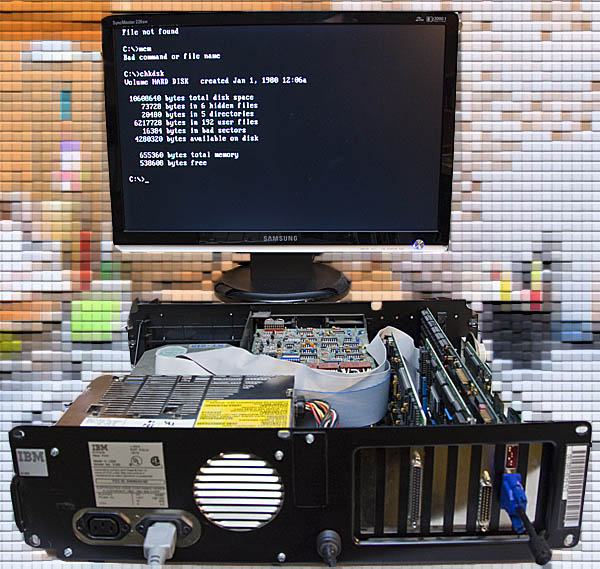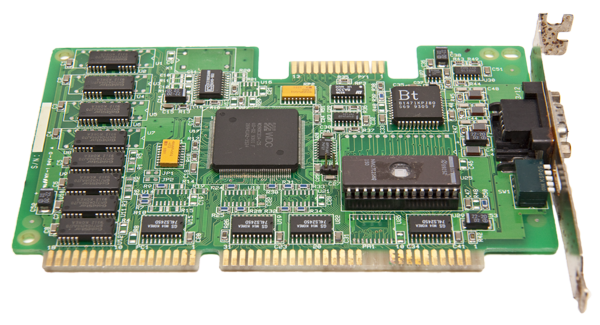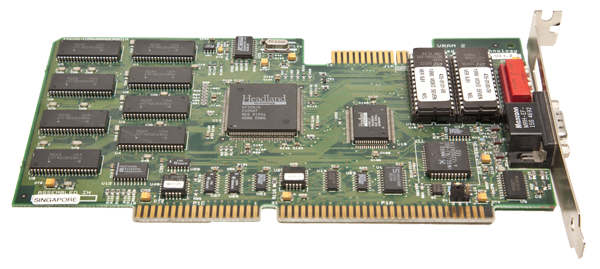
My XT booting up with a 16-bit ISA VGA card
Last time I talked about my PC XT, I didn’t know if it actually worked properly because it had a CGA or similar old video card in it and I don’t have a monitor that supports that standard. Thanks to some helpful friends, I gathered up 3 separate ISA VGA cards to try out in the system. There was just one catch… The IBM PC XT has an 8-bit data bus and all of the video cards I had were 16-bit. One of my friends helpfully explained to me that some 16-bit VGA cards will work in 8-bit mode. I was a bit skeptical but I figured that this guy knew what he was talking about since he cut his teeth on an XT. The list of candidate cards follows:

WDC WD90C31A – I received this card from rkdavis from all the way across the country. Thanks RK, unfortunately I’ve looked up this card and found that it doesn’t support any 8-bit mode. All of the jumpers on the card pertain to refresh rates and other trivial settings. This card survived a flood in the basement of a pizza restaurant apparently so I was really rooting for it to work after I was able to clean it up with Simple Green and a toothbrush but alas, it will end up in another project.

Oak Technology 1570SX(OAK 77) – This is a card that I obtained from REPC, a Seattle area computer recycler. This card was floating around in a HUGE bin of other ISA, PCI and AGP cards that were all being sold as-is for $1/ea. I thought it was a fair gamble. Unfortunately after looking up this card, I was also disappointed that it could not be jumpered for 8-bit mode either.

Headland Video Seven HT209/D – The final card that I tried was a Headland Technology 650-0436-03 r.2. The page that I linked to is not an exact match for this card but apparently the layout is slightly standardized because I flipped SW1-7 and SW1-8 to the open position and it fired right up in glorious color on my flat panel display. This card was provided by my friend James who has had the card in his closet for years with no real use for it. It’s also available on eBay from a bunch of ripoff artists for $75-$150. Granted it WAS a very expensive card when it was new but so what? This card is worth $20 on the right day to the right buyer IMO. Whatever the case, this is the one 16-bit ISA card out of my three that will work in 8-bit mode so I’m very happy.
So next, after I have a working card, the system booted up. I watched in disbelief as it painstakingly counted all 640 kilobytes of memory individually. Next, even more amazingly, the 20MB Seagate MFM hard drive proved to still be functional since MS-DOS 3.2 booted up. DOS 3.2 is missing a few of my favorite programs such as edit.exe but it’s a good, solid version unlike the piece of crap better know as MS-DOS 4.01. The AST clock/ram/controller board miraculously still works as well although it does not appear to be Y2K compliant. It seems like DOS is ok with a 4-byte date but the AST card keeps jumbling it up when you try to set it to a date in the current millennium.
My next project with this system will be to come up with a method of transferring data to and from this system since my MacBook Pro does not seem to be equipped with a 360Kb 5.25″ floppy drive nor does anything else in my house. Once I find a way to transfer this data, I’ll have to decide what that data should be. Decisions, decisions.
I want to give a shout out to Stason for his AWESOME collection of data on old video cards such as these. Without his page, I would still be caught up in a quagmire of experimentation and trial but most of all ERROR.
If you like the content on this site, please support it by using this link to order from Amazon. You know you were going to go there and buy stuff anyhow so why not help me pay the hosting bill.


Oh before I forget I have many unopened boxes of 5 1/4″ floppies do you need any?
I might actually. No rush or anything though. I’m actually looking into these plans for an 8-bit SSD that emulates a floppy but that’s probably far off. Check out this link, it looks kinda cool http://www.microwave.gr/giannopk/computer.htm
this is a handy resource too. http://www.classiccmp.org/dunfield/img/ also i’ve seen/used alot of those emulate a floppy using CF/USB… things. google for SVD and there is another one i’ve used but i forget its name atm. well let me know and i’ll dig out a few boxes.
This is great. are you still using it? Any chance to borrow or purchase the card so I can see what data is on my XT before I recycle it?
Hey RK, still have those floppies kicking around? I’d love to have ’em. Glad to pay the shipping, etc.
Yep, oddly I just pulled it out last night to use it here. I’m thinking the world is ready for an FPGA-based 8-bit vga card to solve this age-old issue. No composite out on your XT eh?
Just want to say thank you for this post. I bought the same card and it works 🙂
Hello there,
I am a retired IT-chap now, but my XT, 2 Floppy’s 360K, Amber Display Osborne, Microsoft DOS 3.2, Editor SPF-PC, Compilers BASIC, BASICA and GWBASIC, Printer NEC P2200, several boxes of floppy discs including a few tutorials DB2, CICS, FileAid, is still in use for teaching and is working fine. If you are interested, you can have it all for a bottle of good american wine from California. But I can’t send it in a parcel to you. So just plan a holiday trip to Europe, to the heart of Germany’s romantic Rhine Area, visit the old Castles, try good drinks and bretzels, and visit me in the town of Bonn and take it all home.
Interested and want some pictures ? Send me an email-adress.
Regards Klaus
BonnData-Band